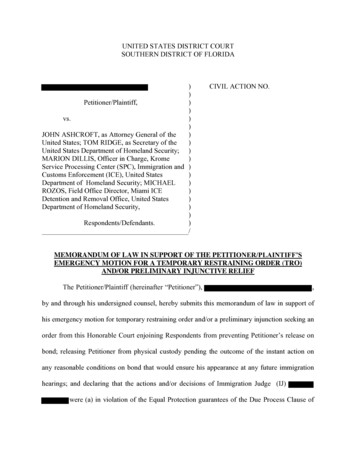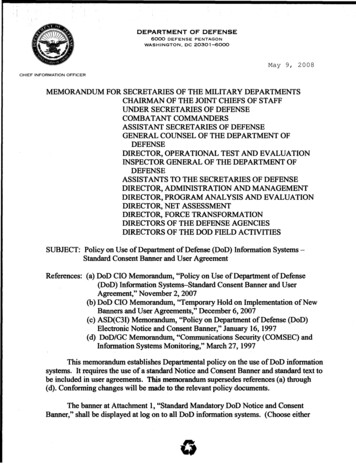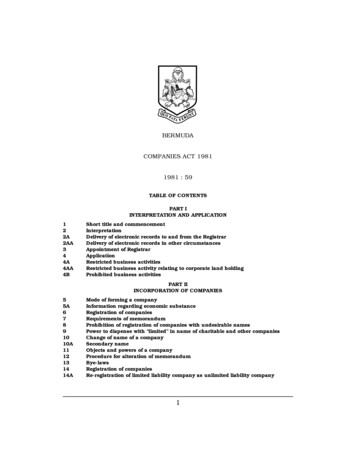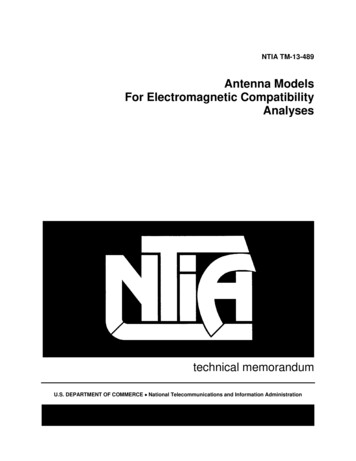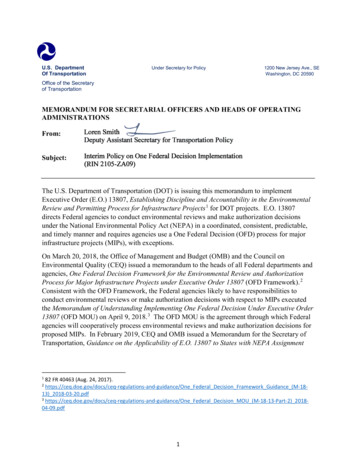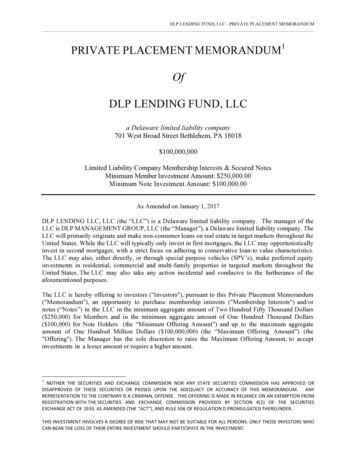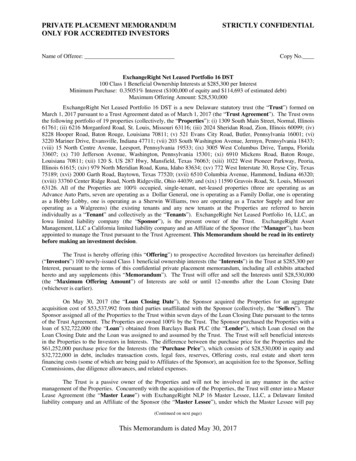
Transcription
Global Tubing LLC v. Tenaris Coiled Tubes LLC et alDoc. 140United States District CourtSouthern District of TexasENTEREDUNITED STATES DISTRICT COURTSOUTHERN DISTRICT OF TEXASHOUSTON DIVISIONGLOBAL TUBING, LLC,Plaintiff,VS.TENARIS COILED TUBES, LLC andTENARIS, S.A.,Defendants.June 23, 2020David J. Bradley, Clerk§§§§§ CIVIL ACTION NO. 4:17-CV-3299§§§§§§MEMORANDUM & ORDERBefore the Court are the claim construction briefs filed by both parties in this patentinfringement suit. On June 10, 2020, the Court held a hearing, in accordance with Markman v.Westview Instruments, Inc., 517 U.S. 370 (1996), during which the parties presented argument insupport of their proposed constructions. After considering the arguments of counsel, the evidence,and the applicable law, the Court finds that the disputed claims of the patents-in-suit should beconstrued as set forth herein.I.BACKGROUNDDefendant Tenaris Coiled Tubes, LLC is the owner of U.S. Patent No. 9,803,256 (the “‘256patent”), U.S. Patent No. 10,378,074 (the “‘074 patent”), and U.S. Patent No. 10,378,075 (the“‘075 patent”). Plaintiff Global Tubing, LLC brought suit against Defendant for, among others,declaratory judgment of non-infringement and unenforceability.This patent dispute involves patents for coiled tubing, which are very long, small-diametersteel tubes that are used in the oil and gas industry to conduct and service wellbore operations. The1Dockets.Justia.com
particular patents at issue provide for coiled tubing that is manufactured with a “quench andtemper” process that makes the coiled tubing stronger and safer to meet the needs of shale oilextraction.II.APPLICABLE LAWIn patent law, “the claims of a patent define the invention to which the patentee is entitledthe right to exclude.” Phillips v. AWH Corp., 415 F.3d 1303, 1312 (Fed. Cir. 2005) (citationomitted). Claim construction is a matter of law, and thus the task of determining the properconstruction of the disputed terms lies with the district court. Markman, 417 U.S. at 385.To determine the meaning of claims, courts begin by considering the intrinsic evidence,which includes the claims themselves, the specifications, and the prosecution history. Phillips, 415F.3d at 1313. Courts look first to the language of the asserted claim itself. Comark Commc’n, Inc.v. Harris Corp., 156 F.3d 1182, 1186 (Fed. Cir. 1998). It is well established that words of a claim“are generally given their ordinary and customary meaning,” which is defined as the “meaningthat the term would have to a person of ordinary skill in the art in question at the time of theinvention.” Phillips, 415 F.3d at 1312–13 (quoting Vitronics Corp. v. Conceptronic, Inc., 90 F.3d1576, 1582 (Fed. Cir. 1996)). A district court is not obligated to construe terms with ordinarymeanings, lest trial courts be inundated with requests to parse the meaning of every word in theasserted claims. O2 Micro Int’l Ltd. v. Beyond Innovation Tech. Co., 521 F.3d 1351, 1360 (Fed.Cir. 2008); see also Mentor H/S, Inc. v. Med. Device All., Inc., 244 F.3d 1365, 1380 (Fed. Cir.2001) (finding no error in the lower court’s refusal to construe “irrigating” and “frictional heat”).The exceptions to the ordinary meaning rule are (1) when the patent applicant acts as his ownlexicographer and explicitly defines the term, and (2) when the specification “reveal[s] anintentional disclaimer, or disavowal, of claim scope by the inventor.” Phillips, 415 F.3d at 1315–2
16.Claims, however, “must be read in view of the specification of which they are a part.”Phillips, 415 F.3d at 1315 (quoting Markman, 52 F.3d at 979). The specification, which describesand illustrates the invention in detail, “is always highly relevant to the claim construction analysis.Usually, it is dispositive; it is the single best guide to the meaning of a disputed term.” Id. (quotingVitronics, 90 F.3d at 1582).Courts may also consider the prosecution history, which provides evidence of how thePatent and Trademark Office (the “PTO”) and the inventor understood the patent. Phillips, 415F.3d at 1317. However, “because the prosecution history represents an ongoing negotiationbetween the PTO and the applicant, rather than the final product of that negotiation, it often lacksthe clarity of the specification and thus is less useful for claim construction purposes.” Id. Still, a“patentee may limit the meaning of a claim term by making a clear and unmistakable disavowalof scope during prosecution.” Purdue Pharma L.P. v. Endo Pharms., Inc., 438 F.3d 1123, 1136(Fed. Cir. 2006); see Cordis Corp. v. Bos. Sci. Corp., 561 F.3d 1319, 1329 (Fed. Cir. 2009). Apatentee could do so by, for instance, clearly characterizing the invention in a way to avoid priorart. See, e.g., Microsoft Corp. v. Multi-Tech Sys., Inc., 357 F.3d 1340, 1349 (Fed. Cir. 2004)(limiting the term “transmitting” to require direct transmission over a telephone line because thepatentee was found to have disclaimed transmission over a packet-switched network by statingduring prosecution that the invention transmits over a standard telephone line). However, “[w]herean applicant’s statements are amenable to multiple reasonable interpretations, they cannot bedeemed clear and unmistakable.” 3M Innovative Props. Co. v. Tredegar Corp., 725 F.3d 1315,1326 (Fed. Cir. 2013).In most circumstances, analysis of the intrinsic evidence alone will resolve claim3
construction disputes. Vitronics, 90 F.3d at 1583. However, if the intrinsic evidence does notresolve ambiguities, a court may also consider extrinsic evidence such as expert witness testimony,dictionary definitions, and legal treatises. Id. at 1585. While extrinsic evidence “can shed usefullight on the relevant art,” it is “less significant than the intrinsic record in determining ‘the legallyoperative meaning of claim language.’” C.R. Bard, Inc. v. U.S. Surgical Corp., 388 F.3d 858, 862(Fed. Cir. 2004).A patent is presumed to be valid. 35 U.S.C. § 282. A claim is invalid for indefiniteness ifit “fail[s] to inform, with reasonable certainty, those skilled in the art about the scope of theinvention.” Nautilus, Inc. v. Biosig Instruments, Inc., 572 U.S. 898, 901 (2010). The partychallenging the validity of a claim must prove indefiniteness by clear and convincing evidence.Takeda Pharm. Co. v. Zydus Pharms. USA, Inc., 743 F.3d 1359, 1366 (Fed. Cir. 2014); ApotexUSA, Inc. v. Merck & Co., 254 F.3d 1031, 1036 (Fed. Cir. 2001); WesternGeco LLC v. IONGeophysical Corp., 876 F. Supp. 2d 857, 871 (S.D. Tex. 2012).III.CONSTRUCTION OF AGREED TERMSA. “bias weld joint[s]”The parties agreed prior to the Markman hearing that the scope of this claim is the“microstructural region corresponding to the strip-to-strip joint that can be performed by PlasmaArc Welding (“PAW”), Friction Stir Welding (“FSW”), or any other welding techniques.” TheCourt adopts this construction.B. “heat affected zone[s]”The parties agreed prior to the Markman hearing that the scope of this claim is “the portionof the base metal that has not been completely melted but whose microstructure or mechanicalproperties have been altered by the heat of welding.” The Court adopts this construction.4
C. “more than 90 volume % tempered martensite” / “at least 95 volume %tempered martensite”The parties agreed prior to the Markman hearing that this claim carries its plain andordinary meaning. The Court adopts this construction.D. “each of the plurality of welded strips comprising: a yield strength greaterthan about 80 ksi”At the Markman hearing, the parties agreed that this term carries its plain and ordinarymeaning. The Court adopts this construction.IV.CONSTRUCTION OF DISPUTED TERMSA. “improved yield strength and fatigue life at weld joints”As the Court held at the Markman hearing, and for the reasons stated on the record, theCourt construes this term as “improved yield strength and fatigue life at weld joints as comparedto conventional coiled tubing.”B. Weight Percent TermsAs the Court held at the Markman hearing, and for the reasons stated on the record, theCourt construes these terms as “about X – about X wt.%” or “up to about X wt. %.”C. “full body heat treatment applied to the coiled steel tube”As the Court held at the Markman hearing, and for the reasons stated on the record, theCourt construes this term as “full body heat treatment composed of at least one austenitization andquenching cycle followed by a tempering treatment, applied uniformly to the coiled steel tube.”D. “homogenous”As the Court held at the Markman hearing, and for the reasons stated on the record, theCourt construes this term as “homogeneous as compared to conventional coiled tubing.”5
E. “uniform distribution of fine carbides”As the Court held at the Markman hearing, and for the reasons stated on the record, theCourt construes this term as “uniform distribution of fine carbides as compared to conventionalcoiled tubing.”F. “a length of coiled steel tube”As the Court held at the Markman hearing, and for the reasons stated on the record, theCourt concludes that no construction is necessary as this claim term carries its plain and ordinarymeaning.V.CONCLUSIONThe disputed terms in the patents-in-suit are construed as set forth in this Order.IT IS SO ORDERED.SIGNED at Houston, Texas, on this the 22nd day of June, 2020.HON. KEITH P. ELLISONUNITED STATES DISTRICT JUDGE6
GLOBAL TUBING, LLC, § § § § § § § § § § § Plaintiff, VS. CIVIL ACTION NO. 4:17-CV-3299 TENARIS COILED TUBES, LLC and TENARIS, S.A., Defendants. MEMORANDUM & ORDER Before the Court are the claim construction briefs filed by both parties in this patent infringement suit. On June 10, 2020, the Court held a hearing, in accordance with .
